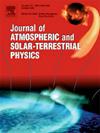Solar radiation on complex underlying surfaces in Xinjiang: A typical arid and semi-arid region in the northwestern China
IF 1.9
4区 地球科学
Q3 GEOCHEMISTRY & GEOPHYSICS
Journal of Atmospheric and Solar-Terrestrial Physics
Pub Date : 2025-08-30
DOI:10.1016/j.jastp.2025.106617
引用次数: 0
Abstract
Xinjiang, located in the northwestern China, is a typical arid and semi-arid region characterized by abundant solar energy resources and highly diverse surface types, including oases, deserts, and snow-covered areas. Solar radiation plays a fundamental role in the Earth's energy budget, governing land–atmosphere interactions and driving essential atmospheric processes. Accurate quantification of downward surface solar radiation (DSSR) over such complex terrains is critical for improving regional climate simulations, optimizing water resource allocation, and facilitating the efficient utilization of solar energy. However, the scarcity of ground-based radiation measurements in this region hinders comprehensive solar resource assessments. Consequently, satellite-derived radiation products, such as those from the Clouds and the Earth's Radiant Energy System (CERES) Single Satellite Footprint (SSF) Aqua dataset, serve as valuable substitutes. Nonetheless, uncertainties in DSSR retrievals over complex surface types necessitate systematic validation. Therefore, in this study the downward surface solar radiation (DSSR) derived from satellite for cloud and all sky conditions were compared with ground-based observations.The CERES-derived DSSR showed overall agreement with ground-based observations in temporal and spatial patterns but tended to overestimate radiation, especially in the southern Xinjiang. Larger discrepancies occurred in Kashgar and Hotan, mainly due to dust from the Taklamakan Desert, which affects satellite retrieval accuracy.Under the clear-sky conditions, CERES DSSR data performed better than that under the all-sky conditions, indicating that clouds had a significant impact on CERES DSSR retrieval, especially in Yanqi and Tacheng. A similar effect is observed in Ruoqiang and Hotan, where the typically low cloud cover suggested that inaccuracies may stem from clouds or the misinterpretation of dust as clouds. Six fitting models were optimized, with results showing that the linear model performed best under the both all-sky and clear-sky conditions at the most stations.
新疆复杂下垫面的太阳辐射:中国西北典型的干旱半干旱区
新疆地处中国西北部,是典型的干旱半干旱区,太阳能资源丰富,地表类型多样,有绿洲、沙漠、雪域等。太阳辐射在地球的能量收支中起着重要作用,控制着陆地-大气的相互作用,并推动着基本的大气过程。在这种复杂地形上准确量化地表向下太阳辐射(DSSR)对于改进区域气候模拟、优化水资源配置和促进太阳能的有效利用至关重要。然而,该地区地面辐射测量的缺乏阻碍了对太阳能资源的全面评估。因此,卫星衍生的辐射产品,例如来自云和地球辐射能系统(CERES)单一卫星足迹(SSF) Aqua数据集的辐射产品,可作为有价值的替代品。尽管如此,在复杂表面类型的DSSR检索的不确定性需要系统验证。因此,本研究将卫星对云和所有天空条件的下表面太阳辐射(DSSR)与地面观测进行了比较。ceres衍生的DSSR在时间和空间格局上与地面观测总体一致,但倾向于高估辐射,特别是在南疆。喀什和和田的差异较大,主要是由于塔克拉玛干沙漠的沙尘影响了卫星反演的精度。在晴空条件下,CERES DSSR数据表现优于全天条件,说明云层对CERES DSSR检索的影响较大,特别是在焉焉市和塔城。若强和和田也观察到类似的影响,那里典型的低云量表明,不准确可能是由于云或将灰尘误解为云。对6个拟合模型进行了优化,结果表明,线性模型在大多数站点的全天候和晴空条件下均表现最佳。
本文章由计算机程序翻译,如有差异,请以英文原文为准。
求助全文
约1分钟内获得全文
求助全文
来源期刊

Journal of Atmospheric and Solar-Terrestrial Physics
地学-地球化学与地球物理
CiteScore
4.10
自引率
5.30%
发文量
95
审稿时长
6 months
期刊介绍:
The Journal of Atmospheric and Solar-Terrestrial Physics (JASTP) is an international journal concerned with the inter-disciplinary science of the Earth''s atmospheric and space environment, especially the highly varied and highly variable physical phenomena that occur in this natural laboratory and the processes that couple them.
The journal covers the physical processes operating in the troposphere, stratosphere, mesosphere, thermosphere, ionosphere, magnetosphere, the Sun, interplanetary medium, and heliosphere. Phenomena occurring in other "spheres", solar influences on climate, and supporting laboratory measurements are also considered. The journal deals especially with the coupling between the different regions.
Solar flares, coronal mass ejections, and other energetic events on the Sun create interesting and important perturbations in the near-Earth space environment. The physics of such "space weather" is central to the Journal of Atmospheric and Solar-Terrestrial Physics and the journal welcomes papers that lead in the direction of a predictive understanding of the coupled system. Regarding the upper atmosphere, the subjects of aeronomy, geomagnetism and geoelectricity, auroral phenomena, radio wave propagation, and plasma instabilities, are examples within the broad field of solar-terrestrial physics which emphasise the energy exchange between the solar wind, the magnetospheric and ionospheric plasmas, and the neutral gas. In the lower atmosphere, topics covered range from mesoscale to global scale dynamics, to atmospheric electricity, lightning and its effects, and to anthropogenic changes.
 求助内容:
求助内容: 应助结果提醒方式:
应助结果提醒方式:


